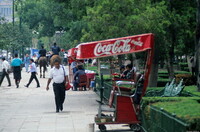Alameda Central [park]
unknown (Mexican)

Download1A2-M-MC-AC-B2_cp.jpg (539.6Kb)
Date
1592Description
Alameda Central is a public park in downtown Mexico City, adjacent to the Palacio de Bellas Artes. The park is a green garden with paved paths and decorative fountains and statues, and is frequently the center of civic events. The area used to be an Aztec marketplace and after the Conquest, the Catholic Church used the area for the burning of heretics and witches. The park was created in 1592, when Viceroy Luis de Velasco decided to create green space here as a public park. The name comes from the Spanish word álamo, which means poplar tree, that were planted here. By the late 19th century, the park included a bandstand and gas (now electric) lamps. On the south side of the park, facing toward the street is the Hemiciclo a Juárez, which is a large white semi-circular monument to Benito Juárez,; Alameda Central is a public park in downtown Mexico City, adjacent to the Palacio de Bellas Artes. The park is a green garden with paved paths and decorative fountains and statues, and is frequently the center of civic events. The area used to be an Aztec marketplace and after the Conquest, the Catholic Church used the area for the burning of heretics and witches. The park was created in 1592, when Viceroy Luis de Velasco decided to create green space here as a public park. The name comes from the Spanish word álamo, which means poplar tree, that were planted here. By the late 19th century, the park included a bandstand and gas (now electric) lamps. On the south side of the park, facing toward the street is the Hemiciclo a Juárez, which is a large white semi-circular monument to Benito Juárez, Source: Wikipedia; http://en.wikipedia.org/wiki/Main_Page (accessed 6/22/2009)
Type of Work
monument; park (recreation area)Subject
architectural exteriors, plants, parks (recreation areas), Nineteenth century
Rights
Rights Statement
Licensed for educational and research use by the MIT community only